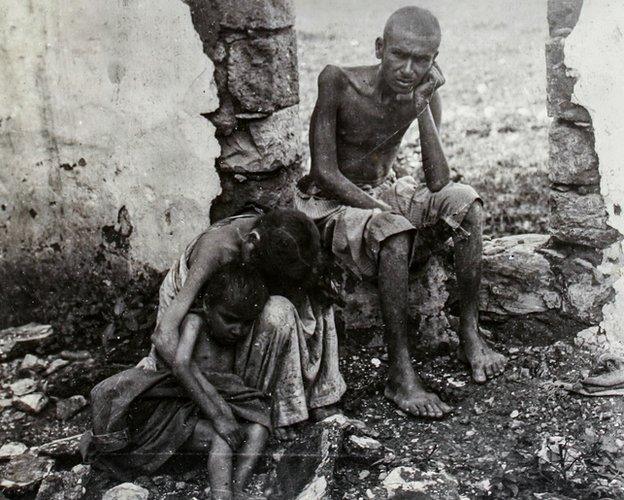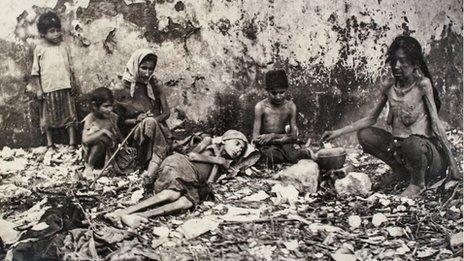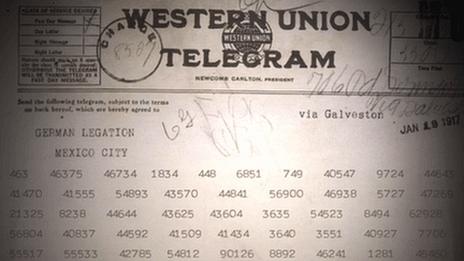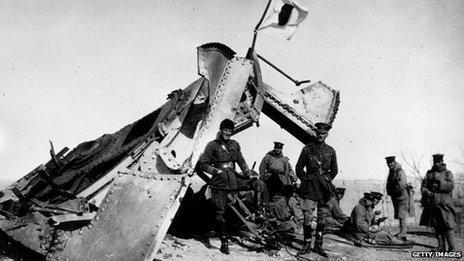Six unexpected WW1 battlegrounds
- Published

The famine of Lebanon resulted in 200,000 deaths
Not all crucial battles in World War One took place on the muddy fields of Europe. Some significant fights took place in little-known places much further afield, says the BBC's Deborah Basckin.
The Somme, Ypres, Passchendaele, all iconic battles of WW1. But what made it a truly global war are the lesser-known tales from Africa, Asia and the Middle East.
New technology, broken promises and shifting alliances meant events which started in Europe had far-reaching consequences beyond the trenches of the Western Front, consequences that still affect millions of people around the world today.
Here are six of the lesser-known battles of WW1.
1. Togo
Pinpointing the exact moment a world event begins is not an exact science, but it could be said some of the very first shots of WW1 weren't fired in Europe. They were fired in West Africa, in the then-German colony of Togo.
In August 1914, troops were massing on the front lines of Europe. But thousands of miles away in the small Togolese town of Kamina, a cutting-edge piece of technology came under threat. With it, Germany's control of the region.
The Germans were using a local workforce to build a wireless station so advanced that its communications could reach as far afield as Asia. It was an incredible military advantage at the time, akin to having email in a time of smoke signals. At the outbreak of WW1, it wasn't fully completed but it was operational.
When war was declared the station immediately came under threat, its worth to any military force incalculable. It was soon surrounded by allied forces.
Without an army, the Germans first tried to marshal a local police force, led by its own soldiers and made up of mercenaries from nearby. But ultimately they were left with no option but to destroy the station and surrender.
The five hours it took for the station at Kamina to burn ended German colonial rule. It marked the first allied victory of WW1 and irrevocably changed Togo's future.


2. Lebanon
One third of the population died in the largely forgotten famine of Mount Lebanon. A devastating confluence of political and environmental factors lead to the deaths of 200,000 men, women and children in the region.
At the outbreak of war, the arid Mount Lebanon was a semi-autonomous area within the powerful Ottoman Empire. Its economy was based on the production of raw silk, which was woven by women in mills and exported to Europe.
But the Ottoman alliance with Germany caused the Allies to cut off international trade routes, damaging the silk trade and choking the economy. Food was scarce and prioritised for the soldiers of the Ottoman war effort. Families started to go hungry.
Then came the locusts. In biblical swathes, the insects swarmed through the region in 1915. They devoured the few remaining crops and delivered a fatal blow to the already starving people.
There were reports of bloated bodies dead in the street, even cannibalism. One account from a Jesuit priest tells of a father coming to confess he had eaten his own children.
Some tried to help and soup-kitchens started to open. Thousands were fed, but there was no way to mitigate the effects of the double blow.
A footnote in some history books, or left out of others altogether, the famine of Mount Lebanon is still painfully remembered by those who live there.


3. Mexico
The length of one of the most aggressively monitored borders in the world runs for 3,145 km (1,954 miles). The iron pillars, concrete walls, security cameras and drones that make it so formidable today were partly triggered by just a tiny bit of paper during WW1 - a telegram.
In 1917, Germany tried to capitalise on the uneasy peace between the US and Mexico - two countries at odds over their shared border.
German Foreign Minister Arthur Zimmermann sent a coded telegram: "We make Mexico a proposal of alliance on the following basis: make war together, make peace together." Its meaning was clear - join the war on Germany's side and secure its help to invade America in return.
Zimmermann hoped by drawing the US into conflict with Mexico it would distract the US from the war in Europe.
The telegram was composed and sent from Berlin. Before it reached its intended destination it was intercepted and decoded, revealing Germany's plans to the world.
So Zimmermann's message to Mexico achieved the very opposite of its aim, helping draw America into WW1.


4. Tanzania
Twice a month, the MV Liemba's prow slices the waters of Lake Tanganyika along its route from Kigoma, at the north, to Mpulungu at the southern tip. The ship's hull carries people, chickens, beer, pineapples - and 100 years of history.
Originally commissioned as the Goetzen, the boat was designed and built in a shipyard in Papenburg, Germany. In 1913 it was shipped in pieces across the Mediterranean Sea, through the Suez Canal and travelled by train over German East Africa - now Tanzania - to the shores of Lake Tanganyika.
In the lakeside town of Kigoma, the boat was assembled by a local workforce, watched over by three German engineers. At the outbreak of WW1, now armed with guns and soldiers, the Goetzen was set to dominate the lake as a German weapon against British and Belgian fleets.
But despite its enormous size and impressive speed, military setbacks on land meant the Germans were forced to scuttle their own "indestructible" boat, saving the guns and making more soldiers available for the fighting on shore.
The same engineers responsible for its construction were tasked with sending the Goetzen to the bottom of the lake. Six years later, she was raised, re-christened and re-purposed.
The boat still runs as a passenger ferry, a lifeline for the people living along the waters' edge and a connection to one of the defining periods in world history.


5. China
The Chinese port city of Tsingtao - modern day Qingdao - came under German rule in 1897. During WW1 it was to become the site of a fatal siege and the cause for continuing antagonism in the east for decades.
By the time the war came to Asia, Tsingtao had evolved from a fishing village into a modern city with German infrastructure, schools and a naval base.
It had also become a strategic outpost for Germany on the other side of the globe and therefore a target for Japanese and British forces, who invaded in 1914.
The Germans were braced for attack. Chinese labourers had been enlisted to build fortifications along the city's steep hills, dig trenches and position artillery.
The city came under siege. For two months it was pummelled from land and sea. Bombs rained down from the new weapons of war - aeroplanes. Overwhelmed by force and without sufficient reinforcements, Germany eventually capitulated. An estimated 450 men died in the siege, 40 of them were Chinese labourers.
Politically the siege had enormous ramifications. Tsingtao was not returned to Chinese rule, but instead the Japanese victors held on to their territory.
After the war the world powers met in Versailles to negotiate the terms of global peace. Japan refused to relinquish Qingdao and China refused to sign the treaty, setting off a chain of events which lead to war 20 years later.


6. Malta
The tiny island of Malta earned the nickname the Nurse of the Mediterranean for its unique role in treating more than 100,000 casualties of WW1. It was a battleground in the sense that medics found themselves struggling to save vast numbers of soldiers suffering from wounds unlike those seen in previous wars.
Malta famously has a medical tradition that stretches back more than 500 years. The war brought that tradition right up to date as the island opened the doors of its 27 hospitals to injured allied soldiers pouring in from the front lines.
The very location of Malta, in the middle of the Mediterranean, was an ideal position to receive casualties from fighting in Turkey and Greece. The wounded, many Australian, were brought to the island by hospital ships and were hoisted up its steep cliffs to the doctors and nurses waiting for them.
What they saw arriving in their hospitals, however, was unprecedented. WW1 was the first industrialised war. It marked the first use of tanks, machine guns and aeroplanes. With new weaponry came horrific new injuries.
Some doctors were adventurous, attempting procedures to treat unfamiliar wounds. But in this time before antibiotics, sepsis was often the ultimate outcome and cause of death. Despite the limitations of medicine at the time, thousands of soldiers passed through the island's care.


Subscribe to the BBC News Magazine's email newsletter to get articles sent to your inbox.